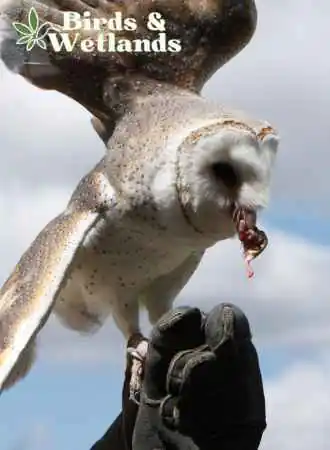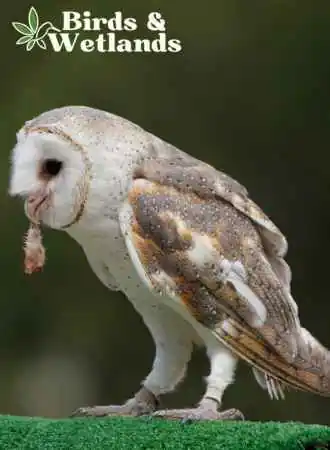Owls are highly adaptable and have been known to hunt in a wide range of habitats, including farmlands where ducks are prevalent.
But do owls eat ducks?
Yes, certain species of owls can and do eat ducks. Larger owl species, like the Great Horned Owl and the Eagle Owl, are known to prey on a wide variety of creatures, including ducks. They are opportunistic predators with powerful talons capable of capturing and carrying off their prey. However, owls typically hunt at night, while ducks are often more active during the day, which can limit the frequency of these interactions.
Key Takeaways on Do Ducks Eat Owls
- Owls are common predators of ducks, especially large owl species that are prone to pounce on domestic animals like ducks and chickens.
- Ducks are vulnerable to predators due to their lack of defense mechanisms, slow speed, and rare ability to fly.
- Different species of owls have different hunting preferences. Large species like great horned owls and red tail owls can easily hunt ducks, while smaller species may rely on insects, frogs and mice.
- Other predators like raccoons, ducks, coyotes, hawks, badgers, and foxes can also pose a threat to ducks.
- While owls typically can’t carry off a grown duck, large species may be able to. They are also known to eat duck eggs.
- Owls use their long, sharp nails to catch a duck, then use their strong beak to kill it. They then take their meal to a high tree.
- Ducks can be protected from owls by making a compact, secure duck house, maintaining a strict schedule for the ducks to be inside before it gets dark, hanging bird repeller reflector tape around the duck area, and tying fishing thread over the place where the ducks are kept.
- Ducks can also be protected by ensuring their nests are kept where they roost, as owls will eat any type of bird eggs if they find them.
- Despite the best protection efforts, it is common to lose a few ducks to predators, especially in areas near forests where many predators are around.
Are Owls Dangerous To Ducks?

Owls are natural predators of many birds, including ducks. These birds of prey use their powerful talons, excellent vision and hearing and strong beaks to swiftly and efficiently capture their prey, thus making them significant threats to ducks.
Owls are also known for their high metabolisms and voracious appetites. They are capable of wiping out whole flocks of unprotected ducks and other poultry. Therefore, birdwatchers and duck farmers need to take precautions against owls to ensure the health and safety of these cherished waterfowl.
What Owls Attack Ducks?
While owls attack ducks, not all types of owls are capable of taking down a duck. Here are the owls that attack ducks:
Great Horned Owls

The great horned owl is a large predatory bird from North America. This owl is characterized by its distinctive ear tufts, rounded heads, and long, broad wings.
Great horned owls are proficient hunters, usually preying on small animals such as rabbits, mice, squirrels and other rodents. Although they rarely go after ducks, they will prey on waterfowl, especially when other food sources are scarce.
Barn Owls
Barn owls are small owls with large, rounded heads and heart-shaped faces. Despite their small size, these birds are well-known for their hunting prowess and are often referred to as “scavenger specialists” due to their ability to take down much larger prey.
While barn owls are not big enough to take down adult ducks, they are more than capable of hunting ducklings.
Snowy Owl

Snowy owls are fierce predators known for their ability to hunt various prey, including mammals, fish, and other birds. These impressive hunters have keen eyesight and sharp talons that allow them to snatch up their quarry in mid-air effectively.
Snowy owls can successfully ambush and kill both ducks and waterfowl. While these birds prefer smaller prey, they are not opposed to hunting large game such as ducks, geese or swans.
Screech Owls
Screech owls are small, nocturnal bird species found throughout North America. These birds have a distinctive call that earned them their name, and they have gained a reputation for being skillful hunters. Due to their small size, they can’t possibly hunt adult ducks but are more than capable of preying on ducklings.
Barred Owls

Barred owls are a type of predatory bird native to North America. Unlike other kinds of owls, barred owls have large wings and long legs, which allow them to fly quickly and maneuver tightly. While barred owls are primarily known for their ability to hunt small mammals like rabbits and rodents, they are also capable of taking down larger prey, such as ducks.
Can an Owl Carry off a Grown Duck?
While owls are fierce and powerful predators, most are simply small or don’t have enough strength to haul a fully-grown duck off the ground. Moreover, ducks tend to be large and heavy, making it even more difficult for an owl to overcome their weight.
Instead, it seems more likely that an owl may take prey in the form of eggs or young ducklings rather than an adult bird. If the duck is heavy, the owl will eat it at the hunting place before leaving.
How Do Owls Eat Ducks?

Owls are common predators of adult and young ducks. These birds may not be the biggest in the animal kingdom, but many species of owls also feed on larger animals, such as ducks, employing various hunting strategies to capture their unwary prey.
A common method owls use to prey on ducks is to attack them while sleeping or resting. Since ducks are often defenseless against apex predators, they are easy prey for an opportunistic owl. In addition, owls may occasionally position themselves near watering holes where ducks congregate to ambush them as they leave.
Most owls employ a tactic called ambush predation. They sit patiently near a duck’s nest or hide in the tall grass until an unwary adult or young duck wanders too close. Once the sitting duck is within reach, the owl emerges from concealment and pounces on it with its sharp talons, frequently carrying it to a nearby tree or other concealed location to continue feeding in private.
Do Owls Eat Duck Eggs?
Owls eat duck eggs on occasion. They have high calcium requirements due to the many growing feathers and bones they need to maintain their relatively large bodies.
In addition, some ducks and owls breed during the same seasons and compete for similar nesting locations. So, owl predation could potentially play a role in the natural cycle.
Owls will not actively search for duck eggs, but if they spot a nest full of unprotected eggs, they will not hesitate to swoop them.
How Do Keep Ducks Safe From Owls

Wild and domestic ducks have many predators, including owls, coyotes, hawks, eagles, foxes and raccoons. Here’s how to protect your flock from owl attacks and other duck predators.
Use a Reflector Tape
To deter owls from attacking your ducks, you can use reflector tape. This tape is designed to reflect the light of headlamps or flashlights, making it look like an eye to birds of prey. Putting this tape on your duck coop or run can dissuade owls from swooping in and harming your beloved feathered friends.
Bird B Gone Reflect-a-Bird Deterrent
The Ultimate Defense Against Unwanted Birds

Pros
- Highly Effective: Using the power of wind and sunlight, this bird deterrent creates a distraction zone that confuses and scares away pest birds.
- Economical and Humane: This silent bird deterrent is not only cost-effective but also humane, causing no harm to the birds.
- Versatile: Whether you’re looking to protect buildings, boats, or agricultural settings, this bird deterrent is suitable for a variety of environments.
- Durable: Made from durable aluminum and plastic, this product is designed for outdoor use and can withstand various weather conditions.
- Adjustable Design: With an angled design that can be adjusted up to 90 degrees, this bird deterrent can be installed in various directions, maximizing its effectiveness.
Cons
- Limited Nighttime Effectiveness: The Bird B Gone Reflect-a-Bird Deterrent primarily uses sunlight to create reflective flashes. Consequently, its effectiveness might be limited during nighttime when owls are most active, as it relies heavily on sunlight for operation.
Keep Your Flock Inside A Coop
A coop or a duck house in your back yard is an ideal place for ducks and chickens to rest and sleep at night, as it protects them from various potential predators.
For instance, owls rarely hunt during daylight hours but they are known to prey on ducks and chickens at night, so a secure enclosure such as duck houses with a lock protects these birds.
Additionally, having a duck house or coop eliminates the need to purchase expensive feeders or other equipment, as the coop’s walls protect the flock from predators.
Whether you’re concerned about a red-tailed hawk, owl, raccoon or fox attack, duck houses can provide the ideal nighttime shelter for your ducks and chickens to keep them safe from many animals and other predators.
TRIXIE Pet Products Natura Duck Coop
Are you looking for a reliable, safe, and accommodating living space for your ducks? The TRIXIE Pet Products Natura Duck Coop is the perfect abode that combines function, comfort, and durability, ensuring your ducks enjoy their surroundings.

Pros
- Spacious Design: The TRIXIE Pet Products Natura Duck Coop provides ample space for your ducks to roam and rest comfortably, promoting their well-being and happiness.
- Convenient Cleaning: With a pull-out plastic tray, this duck coop makes cleaning a breeze, helping maintain hygiene without the usual hassles.
- Robust Construction: Made of glazed pine, this coop is built to withstand the elements, ensuring a long-lasting and sturdy home for your ducks.
- Security: The hinged roof with locking arm can be opened from above, providing easy access while also ensuring your ducks’ security against potential predators.
- Easy Assembly: With all necessary hardware included and a detailed instruction guide, setting up your TRIXIE Pet Products Natura Duck Coop is a simple and straightforward process.
Cons
- Size Limitation: While the TRIXIE Pet Products Natura Duck Coop offers ample space, it may not be suitable for a large flock of ducks. Owners with a significant number of ducks may need to consider additional or larger housing options.
- Lack of Insulation: The design of the coop may not provide adequate insulation in extremely cold climates. Additional measures may be necessary to keep your ducks warm during harsh winters.
Install a Motion Detector Device
Another option that can help protect your ducks from owls is to use a motion detector device. This device can detect any movement or sound in your land and trigger an alarm or bright light that will scare off owls, dogs and other predators. It can deter a coyote, raccoon and hawk as well.
Motion detector devices are easy to install and maintain, making them an ideal choice for any backyard duck keeper looking to keep their birds safe and secure from a predator attack.
Motion-Activated Animal Repellent & Sprinkler
Protect your ducks and other wildlife on your property with an innovative, eco-friendly motion-activated alert sprinkler.

Pros
- Humane and Effective: The Havahart 5277 sprinkler offers a non-toxic, chemical-free solution to alert you when ducks or other animals are near, ensuring their safety.
- Motion-Activated: Equipped with an infrared sensor, this device detects movement up to 35 feet away and releases a burst of water to catch your attention and help protect the animals.
- Adjustable Settings: Customize the sensitivity of the motion sensor and the spray duration to suit your specific needs and prevent false triggers.
- Easy Installation: The device is easy to set up and connects to a standard garden hose, making it simple to deploy in any area of your property.
- Environmentally Friendly: Powered by solar energy and utilizing water as an alert system, the Havahart 5277 is a sustainable and eco-conscious choice for your yard.
Cons
- Limited Coverage: The motion sensor covers a 100-degree arc, which may not be sufficient for larger areas or properties with multiple entry points for animals.
- Weather-Dependent: Since the device relies on solar power, its effectiveness may be reduced during periods of extended cloud cover or in heavily shaded areas.


